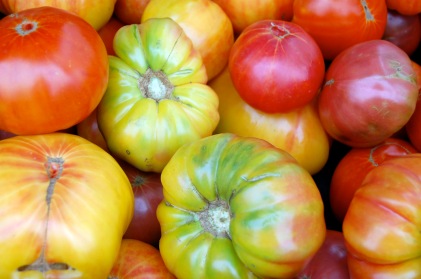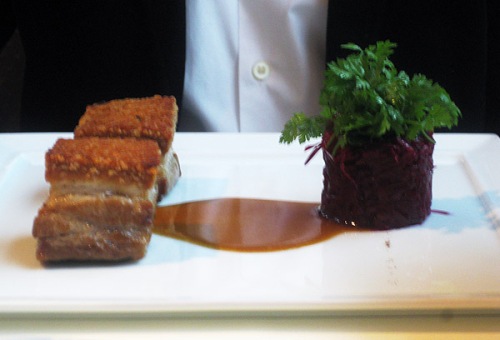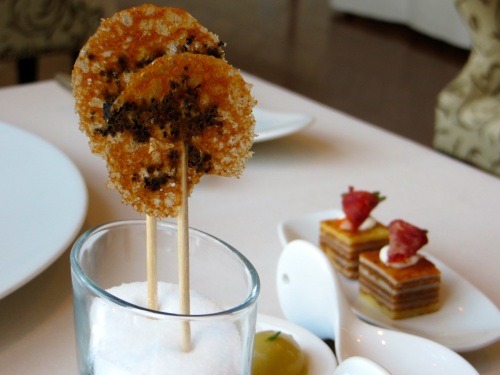
A stand at the Charlottesville farmers market on a recent Saturday – where does a tomato lover even begin?
The Charlottesville farmers markets are a rainbow of tomatoes right now, stripes laid out on benches of soft red, sunset yellow-pink, peach orange, neon green, purple-red.
I usually stare, googly-eyed, at the exotic mix, and then pick up anything basic red that’s $2 a pound and smells like a tomato – that tell-tale burst of nose-tickling aroma you never find in a grocery store stack.
While this amateur method has never steered me wrong, come a recent Saturday, we decided it was time. Time to try heirloom tomatoes.
First, what are heirloom tomatoes? A detective with only visual clues might think: any tomato with (1) a color other than classic red and (2) especially those bulbous oddities, shaped more like a squat mini pumpkin than a baseball and (3) priced above $2 a pound, into the $3 or $4 realm.
I would also add, which is just short of giving this entire taste-test experiment away, (4) an exquisite taste and color far more vivid than any supermarket variety.
Which is more like diagnosing an illness by its symptoms than understanding its essence. Not entirely helpful.
In actuality, heirloom is a fuzzy term for varieties that are open-pollinated (without human help) and have not been crossbred for more than 40 years. They can be family creations passed down through the generations, for example. And unlike supermarket hybrids, which are breed for portability, shelf longevity, and consistent shape and color, heirlooms spoil much quicker. All the more incentive to devour them immediately!

Our first round of tomato tasting. From the purple one, going clockwise: Carbon (purple), Golden Queen (yellow), Virginia Sweet (peach-yellow with rose tints), an unidentified pretty orange variety (any ideas?), Brandywine (blush red), and a sad specimen that snuck in there and tasted like freezer-burned foam. We thought of it as the control group.
For our taste test, we bought a selection of heirloom tomatoes home and invited our friends Erin and Dave – wonderful gardeners themselves – to help us sample them. Here are thoughts on a few of our favorites:
Golden Queen
This lemonade-colored tomato, sliced below, has reportedly been around since the 1880s. We thought it was light, creamy, “like a summer day.” And possibly, we ventured, a nice pairing with goat cheese.

A Carbon tomato and a slice of the beautiful yellow Golden Queen
Carbon
This gorgeous purple-green variety, above, looks like nothing I’ve ever seen in a store. The inside glistens with more of the deep bruised maroon and an outline of kelly green. It tasted a bit acidic, rich, robust. This was the red-wine tomato of the samplings.
Brandywine
This is the most quintessential tomato of the set, the one I imagine is used as a model in creating children’s plastic toy food or the slice on a Burger King Whooper image in larger-than-life ads.
The Brandywine, below, is exactly what you envision a tomato should be. It’s a love tomato, our taste-test friends pointed out, a tomato that begs for mayo and lettuce and a burger.

The stunning Brandywine
And our absolute favorite:
Virginia Sweet

A slice of Virginia Sweet
The huge, squat beauties are a deep yellow with a rosy glow, especially pink on the bottom. As one seed supply company notes, ” This heirloom variety is simply one of the best tasting, best producing gold-red bicolors we have ever grown. On top of that, the tomatoes are stunningly beautiful and enormous, weighing at least 1 pound each.”
The flavor is luscious, nearly peach-like, with a vividness unsurpassed. A bite is so fresh and light, it feels like dipping in a swimming hole. Thick, meaty slices are made for sandwiches. And Virginia Sweets are simply exquisite – you can’t help but marvel at their prettiness.
The only drawback: You must eat them very quickly. Given a week to hang around, Virginia Sweets will descend into mushiness and their sublime sweetness will pass you by.










